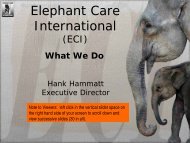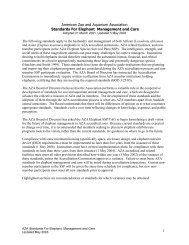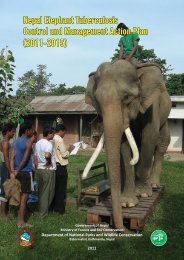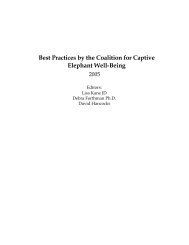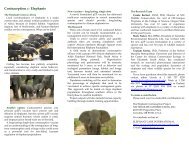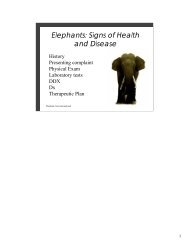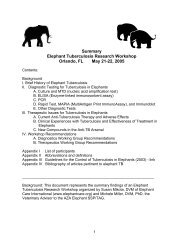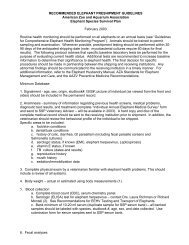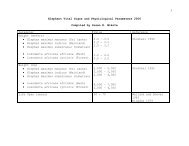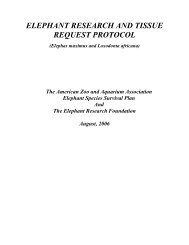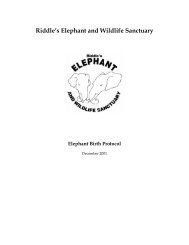Elephants Elephants - Wildpro - Twycross Zoo
Elephants Elephants - Wildpro - Twycross Zoo
Elephants Elephants - Wildpro - Twycross Zoo
- No tags were found...
Create successful ePaper yourself
Turn your PDF publications into a flip-book with our unique Google optimized e-Paper software.
calves as required. For example, separate pens may be composed of moveablebarriers which can be brought in to use when necessary.The minimum indoor stall size for a bull MUST be at least 50 sq. m.Dimensions should be planned around the fact that a mature bull animal canreach vertically up to six metres. Ceilings, plumbing and all electricalinstallations must be out of reach 1 .The inside temperature MUST be no less than 15 O C and there MUST be anarea capable of maintaining a temperature of at least 21 O C for sick ordebilitated animals. Indoor areas MUST be well ventilated, though elephantshave a wide tolerance of humidity. Areas should be well lit with a gradient.Fluorescent lighting spectrum is acceptable but skylights are highlyrecommended. Lighting should not suddenly go from bright light todarkness, but fade gradually and the animals should never be in totaldarkness. Thus a facility for dimming lighting should be present.All collections have to manage the health and welfare of their elephants in amanner that is safe and effective for all concerned. Restraint chutes are widelyaccepted as being a significant asset to that end. Chaining rings, if used,should be placed carefully and only used when necessary, e.g. for training andveterinary purposes; elephants MUST not be routinely chained for periods inexcess of three out of 24 hours (and see SOP on The Use of Chains or Shackleson <strong>Elephants</strong>).Standing water can cause foot problems and be contaminated with pathogens.Floors should be quick drying and well drained, relatively smooth but notslippery and not rough enough to traumatise feet and which can be readilycleaned and disinfected. They should also have a degree of ‘give’ so thatelephants can lie down comfortably. A range of materials is currently usede.g. wood, sand bricks, concrete or other rot-proof material (such as epoxy orrubberised coatings). Recent studies using sand in indoor areas suggest thatthis may provide a good substrate (D.Field, pers comm.). The flooring shouldhave properties that include insulation, so that the floor remains warm. Trialsare underway to select better types of flooring such as earth, deep-litter andrubberised materials2. An adult elephant can discharge 50 litres of urine in 24hours, which normally is slightly acidic and may contain a large amount ofcrystals, much of which is calcium carbonate. Good drainage and a dailyhygiene routine MUST also provide for frequent removal of manure; this willassist with sanitation and aesthetics. In the cold winter months warm watershould be available for washing down animals.Feed troughs need to be designed for filling and cleaning from outside theenclosure. There should be high-level feeders for hay and browse. AnimalsMUST have access to drinking water from the indoor area as well as theoutdoor area and troughs should be cleaned daily. Ideally drinking water inindoor areas should be warm and if possible consumption should bemonitored.1 Indoor are section has been clarified.2 Section on flooring materials clarified and updated.42



